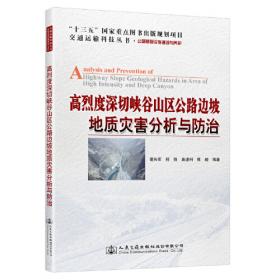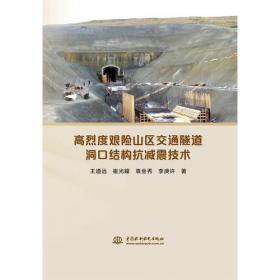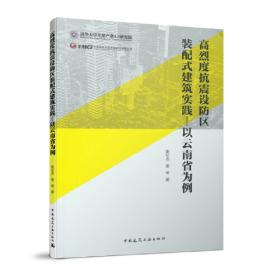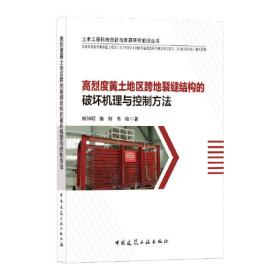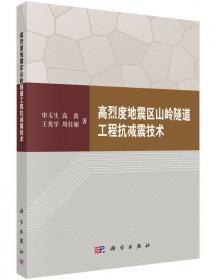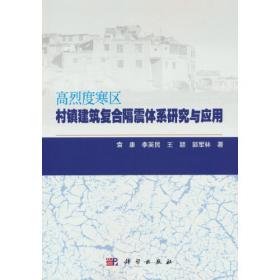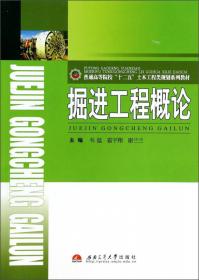高烈度岩爆的超前应力释放控制爆破方法
出版时间:
2020-05
版次:
1
ISBN:
9787568925037
装帧:
平装
开本:
16开
纸张:
胶版纸
页数:
155页
字数:
303.000千字
正文语种:
英语
-
모모With the development of engineering construction in China밃 there are more and more tunnel projects built or planned in western China. Due to the complex geological conditions in these areas밃 and the deepening depth of those tunnels밃 the high geostress in deep tunnels usually leads to various degrees of rock bursts밃 resulting in personal casualties밃 equipment losses밃 delays in construction periods밃 or various economic risks. Many scholars at home and abroad have conducted a lot of researches on rock bursts caused by high geostress밃 and also put forward some preventive measures. However밃 since the occurrences of those rock bursts have such characteristics as uncertainty밃 abruptness and concealment밃 there still exist many disputes in the mechanism밃 systematic monitoring밃 early warning devices and preventive measures of rock bursts. In particular밃 there is no effective countermeasure in the engineering field to control serious high intensity rock bursts. Thus this book studies the deformation mechanism of those high-intensity rock bursts and puts forwards a pre-release de-stress blasting method밃 i.e. by combining with a series of reasonable drilling and blasting parameters밃 an artificially controlled blasting method can be used to weaken the intensity of rock bursts밃 and to provide solutions to the rock bursts in high-stress tunnels and underground projects.
모모Based on the study of the mechanism of the pre-release de-stress blasting for those high-intensity rock bursts밃 combined with numerical simulations밃 some reasonable de-stress blasting parameters are selected밃 including the diameter of the borehole밃 the spacing between boreholes밃 the depth of the borehole밃 the angle of the borehole밃 and so on. Some on-site tests were also held to verify the validity of this method and the rationality of the parameters. Chapter 1 Introduction
1밅1 Background and Significance
1밅2 Foreign and Domestic Researches
1밅2밅1 Current research of rock bursts
1밅2밅2 Current research of geostress pre-relief controlled blasting
1밅2밅3 Current research on numerical simulation of the stability of surrounding rocks
1밅3 Main Research Contents and Technical Route
1밅3밅1 Research contents
1밅3밅2 Technical route
1밅4 Expected Target
1밅5 Main Innovations
Chapter 2 Factors and Preventing Methods of Rockbursts
2밅1 Definition of Rockburst
2밅2 Conventional Evaluation Indexes of Rockbursts
2밅3 Establishment of Numerical Model for Analyzing Factors of Rockbursts
2밅3밅1 Introduction to simulation tools
2밅3밅2 Model establishment and benchmark simulation
2밅4 Impact of Rock\'s Physical and Mechanical Properties on Rockbursts
2밅4밅1 Qualitative analysis of the impact of rock\'s physical and mechanical properties on rockbursts
2밅4밅2 Quantitative analysis of the impact of rock\'s physical and mechanical properties on rockbursts
2밅5 Numerical Analysis of the Effects of Excavating and Supporting Conditions on Rockbursts
2밅5밅1 Numerical analysis of the effects of full-face excavation and stepwise excavation on rockbursts
2밅5밅2 Numerical analysis of the effect of supporting conditions on rockbursts
2밅6 Recommended Ideas for Controlling High-intensity Rock Bursts
2밅7 Summary
Chapter 3 Mechanism of the Pre-release De-stress Blasting for Rockbursts
3밅1 Definition of De-stress Blasting
3밅2 Microscopic Mechanism of the De-stress Blasting
3밅3 Derivation of the Calculation Formula of Residual Stress after De-stress Blasting
3밅3밅1 Derivation of de-stress blasting equation on two-dimensional plane
3밅3밅2 Deduction of the de-stress blasting equation on 3-dimensional plane
3밅4 Role of the Stress Pre-release Loose Circle
3밅5 Factors Influencing De-stress Blasting Effectiveness
3밅6 Summary
Chapter 4 Experimental Study on Rock Mechanics of Surrounding Rocks in Tunnels
4밅1 Lab Environment
4밅2 Test Methods and Results
4밅2밅1 Uniaxial compressive strength test
4밅2밅2 Tensile strength test
4밅2밅3 Normal triaxial compression test
4밅3 Summary
Chapter 5 Optimization of Parameters for Pre-release De-stress Controlled Blasting Based on Numerical Simulations
5밅1 Response Platforms of Numerical Simulation Analysis
5밅1밅1 ANSYS/LS-DYNA numerical platform
5밅1밅2 FIAC 3D numerical analysis platform
5밅2 Calculation Process of De-stress Controlled Blasting
5밅2밅1 ANSYS/LS-DYNA numerical simulation blasting
5밅2밅2 Coupling process of ANSYS/LS-DYNA and FIAC 3D
5밅2밅3 Stress release simulation of de-stress blasting in tunnel
5밅3 Scheme for the De-stress Controlled Blasting
5밅3밅1 Overall plan
5밅3밅2 Design for orthogonal experiment numerical simulation
5밅3밅3 Design for single factor numerical simulation
5밅4 Result Analysis of Numerical Simulations
5밅4밅1 Result analysis of orthogonal experiment numerical simulation
5밅4밅2 Result analysis of single-factor numerical simulation
5밅5 Summary
몴몴
Chapter 6 On-site Tests of Stress Release by Borehole De-stress Blasting
Chapter 7 Application of De-stress Controlled Blasting in Double-shield TBM Tunnel
Conclusion and Outlook
Acknowledgements
References
-
内容简介:
모모With the development of engineering construction in China밃 there are more and more tunnel projects built or planned in western China. Due to the complex geological conditions in these areas밃 and the deepening depth of those tunnels밃 the high geostress in deep tunnels usually leads to various degrees of rock bursts밃 resulting in personal casualties밃 equipment losses밃 delays in construction periods밃 or various economic risks. Many scholars at home and abroad have conducted a lot of researches on rock bursts caused by high geostress밃 and also put forward some preventive measures. However밃 since the occurrences of those rock bursts have such characteristics as uncertainty밃 abruptness and concealment밃 there still exist many disputes in the mechanism밃 systematic monitoring밃 early warning devices and preventive measures of rock bursts. In particular밃 there is no effective countermeasure in the engineering field to control serious high intensity rock bursts. Thus this book studies the deformation mechanism of those high-intensity rock bursts and puts forwards a pre-release de-stress blasting method밃 i.e. by combining with a series of reasonable drilling and blasting parameters밃 an artificially controlled blasting method can be used to weaken the intensity of rock bursts밃 and to provide solutions to the rock bursts in high-stress tunnels and underground projects.
모모Based on the study of the mechanism of the pre-release de-stress blasting for those high-intensity rock bursts밃 combined with numerical simulations밃 some reasonable de-stress blasting parameters are selected밃 including the diameter of the borehole밃 the spacing between boreholes밃 the depth of the borehole밃 the angle of the borehole밃 and so on. Some on-site tests were also held to verify the validity of this method and the rationality of the parameters.
-
目录:
Chapter 1 Introduction
1밅1 Background and Significance
1밅2 Foreign and Domestic Researches
1밅2밅1 Current research of rock bursts
1밅2밅2 Current research of geostress pre-relief controlled blasting
1밅2밅3 Current research on numerical simulation of the stability of surrounding rocks
1밅3 Main Research Contents and Technical Route
1밅3밅1 Research contents
1밅3밅2 Technical route
1밅4 Expected Target
1밅5 Main Innovations
Chapter 2 Factors and Preventing Methods of Rockbursts
2밅1 Definition of Rockburst
2밅2 Conventional Evaluation Indexes of Rockbursts
2밅3 Establishment of Numerical Model for Analyzing Factors of Rockbursts
2밅3밅1 Introduction to simulation tools
2밅3밅2 Model establishment and benchmark simulation
2밅4 Impact of Rock\'s Physical and Mechanical Properties on Rockbursts
2밅4밅1 Qualitative analysis of the impact of rock\'s physical and mechanical properties on rockbursts
2밅4밅2 Quantitative analysis of the impact of rock\'s physical and mechanical properties on rockbursts
2밅5 Numerical Analysis of the Effects of Excavating and Supporting Conditions on Rockbursts
2밅5밅1 Numerical analysis of the effects of full-face excavation and stepwise excavation on rockbursts
2밅5밅2 Numerical analysis of the effect of supporting conditions on rockbursts
2밅6 Recommended Ideas for Controlling High-intensity Rock Bursts
2밅7 Summary
Chapter 3 Mechanism of the Pre-release De-stress Blasting for Rockbursts
3밅1 Definition of De-stress Blasting
3밅2 Microscopic Mechanism of the De-stress Blasting
3밅3 Derivation of the Calculation Formula of Residual Stress after De-stress Blasting
3밅3밅1 Derivation of de-stress blasting equation on two-dimensional plane
3밅3밅2 Deduction of the de-stress blasting equation on 3-dimensional plane
3밅4 Role of the Stress Pre-release Loose Circle
3밅5 Factors Influencing De-stress Blasting Effectiveness
3밅6 Summary
Chapter 4 Experimental Study on Rock Mechanics of Surrounding Rocks in Tunnels
4밅1 Lab Environment
4밅2 Test Methods and Results
4밅2밅1 Uniaxial compressive strength test
4밅2밅2 Tensile strength test
4밅2밅3 Normal triaxial compression test
4밅3 Summary
Chapter 5 Optimization of Parameters for Pre-release De-stress Controlled Blasting Based on Numerical Simulations
5밅1 Response Platforms of Numerical Simulation Analysis
5밅1밅1 ANSYS/LS-DYNA numerical platform
5밅1밅2 FIAC 3D numerical analysis platform
5밅2 Calculation Process of De-stress Controlled Blasting
5밅2밅1 ANSYS/LS-DYNA numerical simulation blasting
5밅2밅2 Coupling process of ANSYS/LS-DYNA and FIAC 3D
5밅2밅3 Stress release simulation of de-stress blasting in tunnel
5밅3 Scheme for the De-stress Controlled Blasting
5밅3밅1 Overall plan
5밅3밅2 Design for orthogonal experiment numerical simulation
5밅3밅3 Design for single factor numerical simulation
5밅4 Result Analysis of Numerical Simulations
5밅4밅1 Result analysis of orthogonal experiment numerical simulation
5밅4밅2 Result analysis of single-factor numerical simulation
5밅5 Summary
몴몴
Chapter 6 On-site Tests of Stress Release by Borehole De-stress Blasting
Chapter 7 Application of De-stress Controlled Blasting in Double-shield TBM Tunnel
Conclusion and Outlook
Acknowledgements
References
查看详情
-
全新
重庆市綦江区
平均发货16小时
成功完成率81.7%
-
全新
天津市河北区
平均发货26小时
成功完成率78.92%
-
全新
广东省广州市
平均发货17小时
成功完成率94.35%
-
全新
广东省广州市
平均发货17小时
成功完成率95.09%
-
全新
湖南省邵阳市
平均发货4小时
成功完成率83.78%
-
全新
北京市西城区
平均发货11小时
成功完成率93.6%
-
 2
2
全新
江苏省无锡市
平均发货10小时
成功完成率96.72%
-
全新
北京市顺义区
平均发货11小时
成功完成率94.15%
-
全新
天津市河东区
平均发货25小时
成功完成率87.88%
-
全新
北京市朝阳区
平均发货12小时
成功完成率84.18%
-
全新
北京市房山区
平均发货13小时
成功完成率91.18%
-
全新
江苏省无锡市
平均发货8小时
成功完成率96.32%
-
 5
5
全新
北京市丰台区
平均发货28小时
成功完成率86.24%
-
全新
河北省保定市
平均发货15小时
成功完成率92.03%
-
全新
天津市西青区
平均发货15小时
成功完成率94.56%
-
全新
北京市海淀区
平均发货9小时
成功完成率97.6%
-
全新
河北省保定市
平均发货26小时
成功完成率89.77%
-
全新
北京市东城区
平均发货22小时
成功完成率87.77%
-
全新
河北省保定市
平均发货28小时
成功完成率90.23%
-
全新
广东省广州市
平均发货7小时
成功完成率89.57%
-
全新
四川省成都市
平均发货16小时
成功完成率89.91%
-
全新
江苏省南京市
平均发货15小时
成功完成率81.79%
-
全新
江苏省南京市
平均发货7小时
成功完成率95.63%
-
全新
北京市通州区
平均发货9小时
成功完成率90.2%
-
全新
四川省成都市
平均发货13小时
成功完成率92.38%
-
全新
山东省泰安市
平均发货23小时
成功完成率90.98%
-
全新
北京市通州区
平均发货10小时
成功完成率91.69%
-
全新
北京市丰台区
平均发货7小时
成功完成率92.96%
-
全新
北京市通州区
平均发货8小时
成功完成率95.83%
-
全新
广东省广州市
平均发货10小时
成功完成率94.83%
-
全新
山东省泰安市
平均发货8小时
成功完成率91.78%
-
全新
山东省泰安市
平均发货8小时
成功完成率92.4%
-
全新
河北省保定市
平均发货8小时
成功完成率71.43%
-
全新
山东省泰安市
平均发货10小时
成功完成率89.47%
-
全新
山东省泰安市
平均发货7小时
成功完成率75.83%
-
全新
北京市朝阳区
平均发货16小时
成功完成率77.33%
-
全新
河北省保定市
平均发货32小时
成功完成率87.47%
-
全新
河北省保定市
平均发货22小时
成功完成率81.95%
-
全新
河北省保定市
平均发货21小时
成功完成率80.91%
-
全新
广东省广州市
平均发货8小时
成功完成率88.05%
-
全新
-
全新
北京市通州区
平均发货9小时
成功完成率93.68%
-
全新
-
全新
江苏省无锡市
平均发货5小时
成功完成率98.05%
-
全新
江苏省无锡市
平均发货14小时
成功完成率87.46%
-
全新
江苏省无锡市
平均发货5小时
成功完成率97.19%
-
全新
江苏省南京市
平均发货15小时
成功完成率81.79%
-
全新
江苏省无锡市
平均发货7小时
成功完成率95.63%
-
全新
北京市海淀区
平均发货8小时
成功完成率94.09%
-
全新
北京市通州区
平均发货36小时
成功完成率84.21%

 占位居中
占位居中






































































